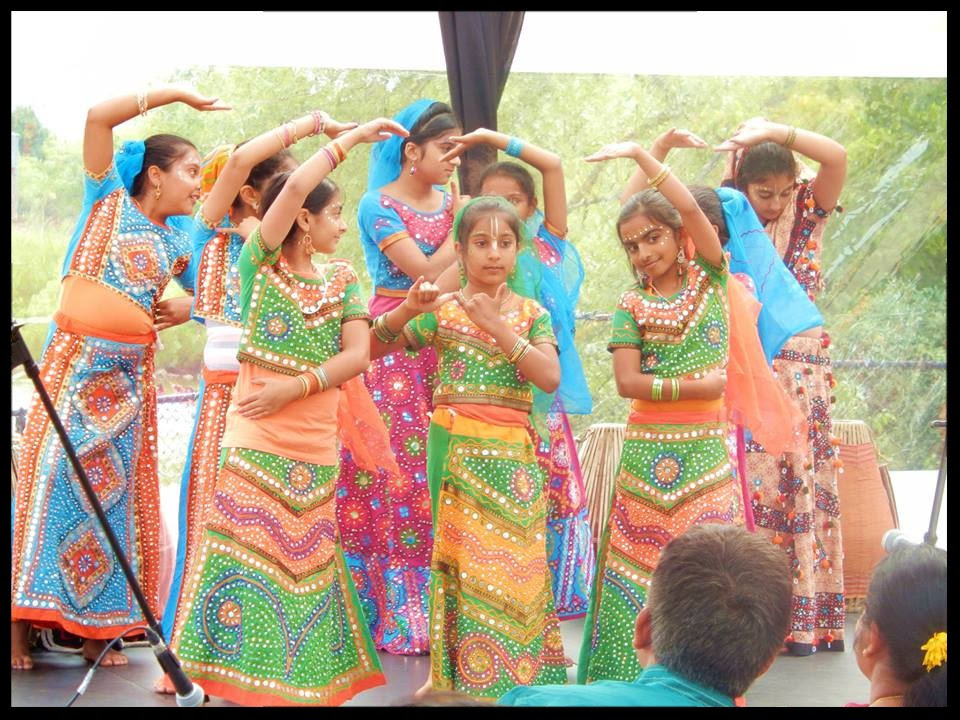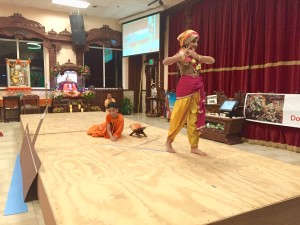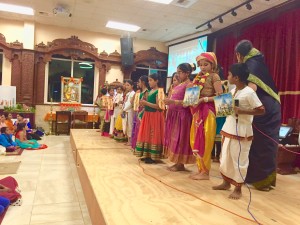
By Rsiraja Das
Einstein’s Religion
Einstein once said that “If there is a religion that could correspond to the needs of science, it would be Buddhism.” Why Buddhism? That is because in Buddhism there is no soul or God. The ultimate reality is a void, which would resonate with the scientific idea that the universe springs from a space-time vacuum. In Einstein’s theory of relativity, matter emerges from the curvature in space-time and to produce matter, curvature has to be added to space-time. Similarly, in atomic theory, quantum particles are created from the fluctuations of a vacuum. These fluctuations cannot, at present, be predicted, although the theory says they are probable. How this probability becomes a reality requires the addition of something that does not presently exist within science (the standard interpretation of quantum theory requires a collapse postulate that converts the probabilities into reality). Curvature of space-time and fluctuations in space-time represent the form in nature, which produces individual objects and their aggregations. Modern science, however, believes that all forms are outcomes of random occurrences or chance events. A more acceptable term in modern science is to call these forms emergent rather than fundamental properties of nature. From physics to biology, form is regarded as a consequence of random effects in nature. In quantum physics, the form appears as a random fluctuation in the vacuum which produces sub-atomic particles. These sub-atomic particles combine to form atoms and molecules. By the time we get to complex molecules, a lot of things are possible. Biologists now claim that living beings are produced through random mutations in these molecules. [1]
What Are Impersonalism and Voidism?
The scientific idea that form is a random and emergent property in nature is echoed in the spiritual philosophies of impersonalism and voidism which claim that the ultimate reality is formless, and forms are temporary effects. When reality is identified as something that exists eternally without changing, these forms are regarded as illusions, because although they appear to us in observations, they are not permanent. Some of these philosophies regard forms to be byproducts of our actions. Since actions are temporary, the forms are impermanent and hence illusory. Impersonalism and voidism claim that the ultimate reality is formless. Impersonalism claims that ultimate reality is a non-dual ‘substance’ in which the duality of form and object does not exist. Voidism claims that the ultimate reality is nothingness, in which the idea of a non-dual substance is also discarded. While impersonalism regards the non-dual reality as consciousness, voidism denies even the existence of consciousness. In voidism, there is no experiencer beyond the experience. Both the experiencer and the experience are created simultaneously.
In recent times, many attempts to bring science and religion together have been motivated from the impersonalist and voidist philosophical stances. Buddhism is a philosophy of voidism while Advaita Vedanta is a philosophy of impersonalism. On the face of it, there is tremendous synergy between science and these ideologies of formlessness because science too tries to describe the ultimate reality as a formless vacuum. In both cases, forms are emergent rather than fundamental properties of nature. However, once you acknowledge that ultimate reality is formless, it hardly matters whether you call it space-time, nothingness or oneness. These are more or less equivalent formulations of the same basic idea.
A History of Impersonalism and Voidism
In Indian philosophy, impersonalism (the idea that there is an ultimate being, although that being is formless) arose several centuries ago in the philosophy of the great savant Sankarāchārya who produced an interpretation of Vedanta Sutra (the summarized conclusions of the Vedas) arguing that Brahman is real while this world is unreal. Impersonalists quote the Vedantic aphorism: brahma satyam jagat mithya, implying that Brahman or oneness is real while the manifest universe of differentiated forms is unreal. Since the experience of the individuality of observers is also part of the worldly experiences, the impersonalist claims that the distinction between observers is false. There is hence only a single observer that is segregated into many observers and their experiences, and this separation is an illusion. Only the single consciousness that existed prior to the creation of many observers is therefore real.
Sankarāchārya’s impersonalism was a response to the inroads that the philosophy of Buddhism was making in Indian society around 8th century AD. When it started, Buddhism had criticized the rampant ritualism (often without a profound philosophical grounding) prevalent in Indian society at that time. But in thus criticizing the Vedic religion, Buddhism gradually undermined the authority of the Vedas themselves. Centuries later, Sankarāchārya revived the Vedic religion’s philosophy, restoring the authority of the Vedas, although he also rejected the practices of rituals. His work led to a new interpretation of Vedanta Sutra, in which ultimate reality is conceived as being formless and impersonal.
Buddhism had claimed that both the observer and the observed are unreal, and to know ‘reality’ one must know the emptiness in which neither subject nor object are real. Sankarāchārya reinstated the existence of a transcendental subject without rescuing the material world from non-existence. But how much better is the undivided oneness of a transcendental observer than the emptiness of space-time is questionable. If you cannot use distinctions, you cannot use language. Both oneness and nothingness are just words which can mean something only in contrast to something that exists different from these ideas. It may not mean that oneness and nothingness are unreal. However, it does mean that we cannot speak about them using language in the conventional sense because every word or sound represents a form, although both voidism and impersonalism employ words that refer to the formless.
Compare impersonalism and voidism with modern science. Here, only matter is real and the observers, although conscious, are also material. In the predominant way of thinking about conscious observers today, consciousness is an attribute of brains. Although what exactly in the brain makes it conscious is still not known, the belief is that this ideology, when pursued sufficiently, will give us the answers. Both observers and the phenomena they observe in science are this-worldly and not other-worldly. Furthermore, matter is itself not fundamental. Rather, the differences between objects are produced from an undifferentiated space-time. What causes their production remains an unsolved problem in science.
There is hence a considerable philosophical synergy between the ideas of impersonalism, voidism and materialism in modern science. However, this similarity between these three viewpoints also implies that they inherit the common problem of converting the formless into something with form. The formless is undivided and undifferentiated while things with form are divided and differentiated. The problem of form can therefore also be stated as the problem of how a singular reality becomes differentiated into individual objects. Only when reality is differentiated can be it known, spoken about, and described in language. Materialism, impersonalism and voidism do not explain the advent of form and language.
The similarities between voidism (where the ultimate reality is a void or nothingness), impersonalism (where the ultimate reality is an undifferentiated oneness) and scientific materialism (where the ultimate reality is space-time), have prompted some scientists (e.g., Einstein) and New Age spiritualists (e.g., Deepak Chopra) to see these parallels as avenues for reconciling the materialism in science with the mysticism in religions. These attempts at reconciliation however can get very confusing for many scientists and spiritualists alike. For instance, if reality is ultimately formless and living beings are accidents of the conversion of formlessness into form, then the practice of religion is an accident of nature as well. Why would we treat the religious experience as something profound if we do not treat the mundane experiences as equally profound?
The Problem of Impersonalism and Voidism
The central difficulty in the philosophies of impersonalism and voidism is the inability to explain how the manifest world of forms is created from the formless. For instance, if the universe prior to creation is oneness, then how is that oneness divided into many parts? If the universe is emptiness prior to creation, then what converts that emptiness into objects? The scientific counterpart of these questions is: If space-time is the fundamental entity from which the universe springs, then what causes the random fluctuation in that space-time, which, in turn cause the manifest universe? Without such an explanation, the theory of nature is incomplete because it cannot explain the origin of form from the formless.
In recent times, there have been attempts to solve this problem by postulating consciousness as a transcendent entity that creates the forms. For instance, some New Age thinkers claim that nature is a quantum probability wavefunction that consciousness collapses into definite states out of its choices. This consciousness, the spiritualist claims, is an impersonal cosmic consciousness, the field of choices in which the world of experience is created. But this idea of a cosmic impersonal consciousness is a misnomer because the idea of choice and the idea of oneness are incompatible; choices imply individuality, and if consciousness can choose, then it must be an individual. Choices without individuality cannot exist. The idea of cosmic conscious choices thus leads to inconsistency. However, without the notion of a transcendent consciousness, there is no explanation for the emergence of form from the formless. In that scenario, the scientific explanation of nature is incomplete.
Science is already being stalked by problems of incompleteness and inconsistency which spirituality is supposed to solve. For, if science was already complete and consistent, then there would be no need for a spiritual alternative. By adopting impersonal and voidistic approaches, however, we again inherit problems of inconsistency and incompleteness, this time from the spiritual notions.
It has become customary in science to attribute anything that the scientific theory cannot explain to randomness. Thus space-time can randomly produce particles, and these randomly created particles can randomly combine to form complex molecules, which can randomly combine to produce living beings. By injecting the idea of randomness into a logical-empirical explanation of nature, such theories violate the fundamental goal in science which is to provide predictable cause-effect relationships. Those who propose randomness as an explanation of currently unexplained facts believe that they are proposing a unique scientific idea, but a closer look reveals that they are proposing infinitely many unique ideas.
Most impersonalist and voidist religious philosophies ride on this dogmatic approach to science. Just as matter can ‘emerge’ from the collapse of the wavefunction or changes to the geometry of the space-time in physical theories, impersonalism and voidism suggest that forms are created from something formless. While claiming to provide a ‘synthesis’ of science and religion, in so far as the problem about the conversion of formless to form is concerned, we would not have moved an inch in neither religion nor science.
Form and Personalism
There is another school of Indian philosophy—much older than both Buddhism and impersonalism—that provides a radically different view of creation. In this view, there are two things—the formless and form—which combine to create the universe. Matter is formless, and it can be equated with the space-time of science, the oneness of impersonalism or the emptiness of voidism. This matter is undifferentiated; that is, matter exists but objects don’t. Objects are created when form is combined with the formless. This form originates as choices of individuals—both God and the living souls. Individuality here is simply synonymous with free will and choice. If a living being has free will, he or she must be different from other living beings because they can choose differently.
The combination of conscious choices and formless matter produces the world of differentiated objects. Essentially, choices divide the undivided into individuals. Both form and the formless are said to be eternal and real in this school of philosophy. However, their combination is not eternal. The material universe is therefore not always real although the constituents of that universe are.
This school of thought is sometimes called the personalist school in Indian philosophy because the idea of choice requires an individual and if choices create form in nature then there must be a priori real individuals, or persons. In the personalist philosophy, the free will of consciousness is an inalienable definition of being a person. It is due to its innate free will that a soul is always individual. Souls can temporarily suspend their free will and appear to lose their individuality, whereby they are said to be merged into a single undivided existence called Brahman. But this suspension of free will is different from the illusion of free will. If there is free will to begin with, then it can be suspended to create oneness. But if there is no free will (because all forms of individuality are illusory), then it cannot be createdfrom oneness. If individuality is fundamental, then it can create oneness. But if oneness is fundamental then it cannot create individuality. In the personalist school, therefore, individuality is said to be fundamental, from which oneness is created when the living being chooses to discard its own free will.
The idea of free will is not reducible, neither to matter nor to an undivided being. It cannot be reduced to matter because free will can create new ideas while matter cannot produce anything new; matter can only be transformed from one state to another. The exact counterpart of this difference in the material world is that information can be created or destroyed but energy cannot be created or destroyed (energy must always be conserved although it can be transformed). Since free will can produce new information, while matter cannot, free will cannot be material. Free will is also different from existence for the simple reason that existence is always undifferentiated while free will is always differentiated.
While a living being may temporarily suspend its free will, and thereby merge into the oneness of a unified existence, this free will remains an innate property that can spring forth at any time. The state of oneness is therefore temporary, while free will is eternal. If you have free will you can give it up. But if you don’t have free will you cannot create it. The fundamental paradox of form in impersonalism, voidism and materialism cannot therefore be solved, because these attempt to create form from something formless. The personalist view postulates that form already exists as individual conscious beings whose free will is the symptom of their individuality. In Vedic philosophy, consciousness or chit is actually free will or the choice to attend to some facts. Consciousness is not an automatic imprint on a passive ‘awareness.’ Rather, a conscious being chooses to become conscious of the world and can also withdraw from the world. Consciousness is therefore identical with choice and there cannot be consciousness without free will. The impersonalist notion of an impersonal and formless consciousness that is devoid of free will (and individuality) is therefore a misnomer. All conscious beings must have a form although by suspending that individuality, a soul can be merged into formless existence.
Through the development of free will, an individual soul acquires a personality, which is also a free construction. Once this personality is developed, there is a need to know and express this personality. Now, the personality is externalized in matter as objects that are essentially reflections of the individual’s persona.
In Vedic philosophy, creation begins when the free will is objectified as a language of forms. This language gives a ‘form’ to the individual making him a unique type of person. This personality is then expressed as the identity of me and mine, and in due course, into propositions about the self, which then become sensations, which are then objectified as symbols of meaning—matter.
Forms and Choices
Every form therefore originates as a choice. Choices individuate a formless existence into a person and then objectify this personality into self-identity, intents, concepts, sensations and things. The living being is said to be ‘caught’ in the material world, but this world is compared to a ‘web’ that the spider has produced out of itself. Through its choices, the living being encages itself into a material identity, intelligence, mind, senses and finally a material body. The impersonalists jump at this problem and claim that since the root of the problem is the use of free will, we must discard the free will and merge into a single, undivided, undifferentiated, oneness.
The personalist however claims that the free will cannot be discarded. It can temporarily be suspended, but it will rise again and encage the living being, unless it is used in a new way. Spirituality in Vedic philosophy begins with the idea that there are uses of the free will that do not encage it. While a detailed description of this use of free will is out of the scope of this essay, the fundamental point that I wanted to make here is that the formsin nature are not emergentproperties. They are rather a fundamentalproperty. Form can be suspended when free will is suspended and the world returns to being formless. But form cannot be created from the formless. Ideas about formlessness in impersonalism, voidism and materialism have a challenge on their hands—namely to explain the emergence of form from the formless. Postulating that form is created due to randomness in nature is not truly an explanation.
We can pretend that randomness is a scientific idea, but such theories will in the future be superseded by others that actually describe form in new ways. The next article discusses the relation between form and science and how ideas about form can and will transform science in unprecedented ways. The key takeaway from here, that I wish to highlight, is that impersonalism and voidism add nothing to science that science is not already doing through its materialist ideology. Impersonalism and voidism are pseudo-spiritual reinterpretations of the materialist philosophy in science. Do we really need them in science? I personally don’t think so.
The personalist approach appears to be much more interesting, because it indicates that all variety and individuality in the world are ultimately products of choices and not randomness. Choices are first objectified as subtle information, which is then embodied into objects. Vedic philosophy then describes the stages through which choices are gradually objectified into matter. This objectification or the expression of choices is governed by two kinds of natural laws. First, there are semantic laws of information combining which dictate how the interaction of two semantic objects produces another semantic effect. Second, there are moral laws of information combining which determine the reaction to the act of combining itself. The semantic effect of combining is purely in matter, but the moral reaction acts on the conscious observer.
Both these types of laws can be studied in nature and they present an alternative material science produced from the effects and reactions of conscious choices. Such a science of choices will lead us to some profound questions about the origin of the universe: How are choices themselves produced? In Vedic philosophy, choices are information which can be produced by an individual soul. In the material universe, this information is short-lived and is eventually destroyed by the effect of Time. However, the soul is never destroyed by Time and it continuously produces information through its choices (which, as we saw above, are identical to consciousness). In Vedic philosophy, therefore, the very act of being conscious produces choices, which are objectified as information, which in turn differentiates matter into objects. Similarly, the universe of individual objects is dissolved into an undifferentiated material existence when consciousness stops its conscious choices [2].
When information is destroyed by the effects of Time, the objects are unmanifest and cannot be known. However, since the soul is never destroyed, it can create new information. In short, while matter is conserved, information is not. The total amount of matter when the universe is manifest is equal to the total amount of matter when the universe does not exist. The difference between the existence and non-existence of the universe is therefore the total amount of information that is added to undifferentiated matter to produce a cosmos of individual objects.
If information is the byproduct of randomness in emptiness, we wouldn’t be able to causally explain the origin of information. If information originally exists in matter, and consciousness experiences it, then we would not be able to explain why information is semantic. It is only when information originates in consciousness and is then objectified in matter, that we can causally explain the origin of information as well as why this information is semantic.
Notes:
[1] This essay was previously published in my book
Is the Apple Really Red?
[2] This claim might prompt some readers to ask: Does the universe disappear or become unmanifest when I close my eyes? In Vedic philosophy, even when we are unaware of the existence of the world, there is a form of God called Paramātma who continuously observes (and thus maintains) the universe by observation. The universe is annihilated when this form of God withdraws His consciousness. This is further detailed in the book Six Causes.






















 By Mahatma Das
By Mahatma Das By Tamohara dasa
By Tamohara dasa By Bhurijana dasa
By Bhurijana dasa








































